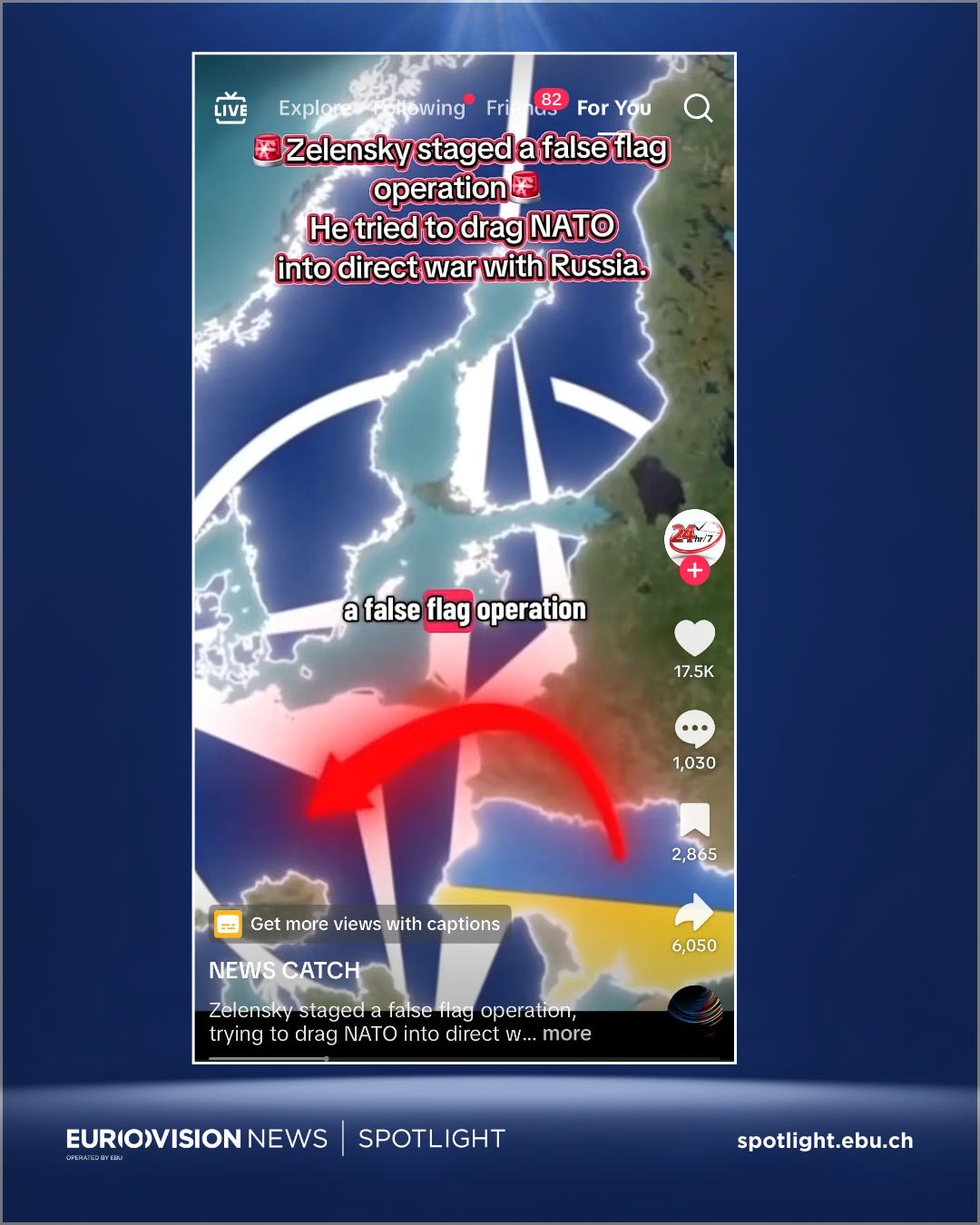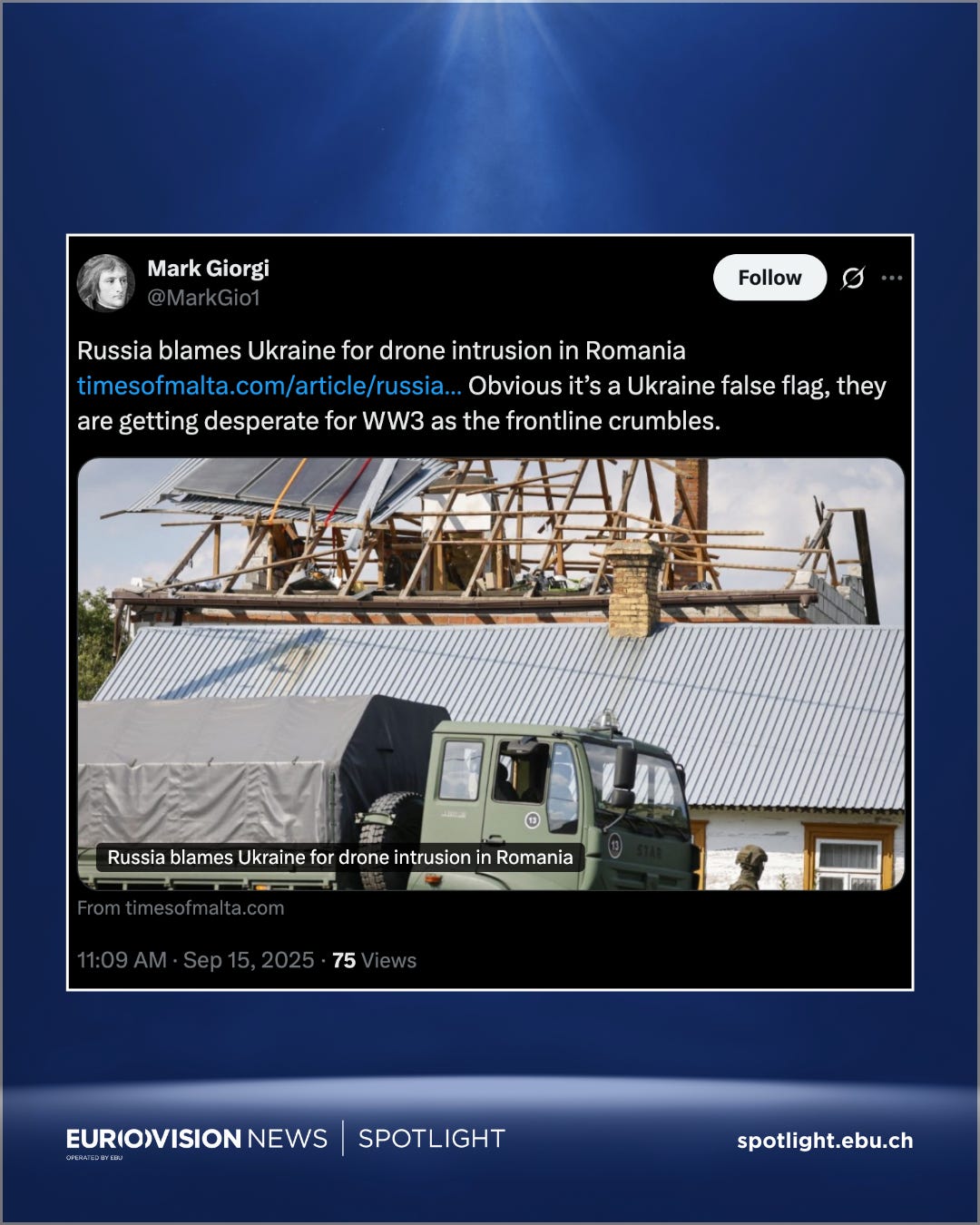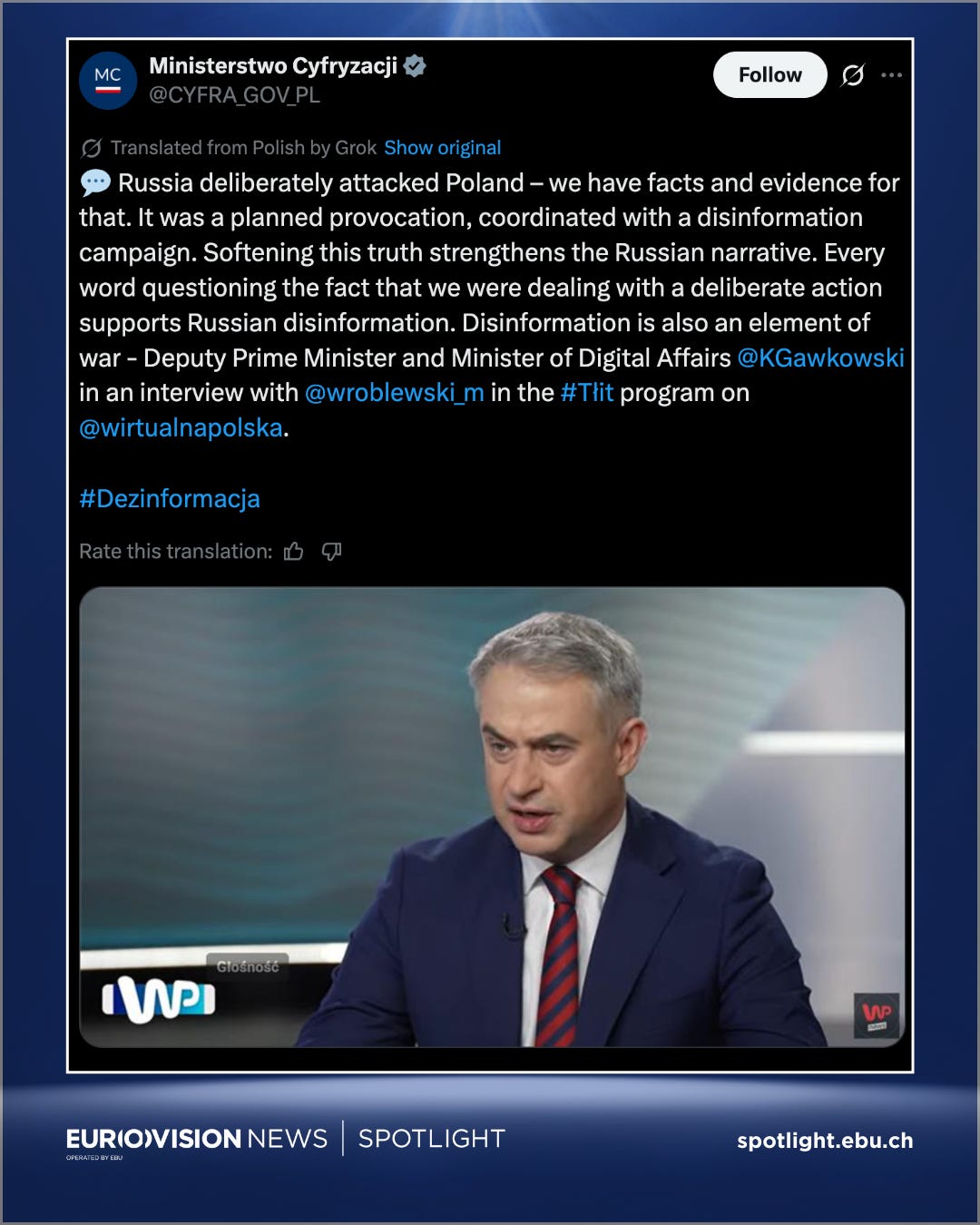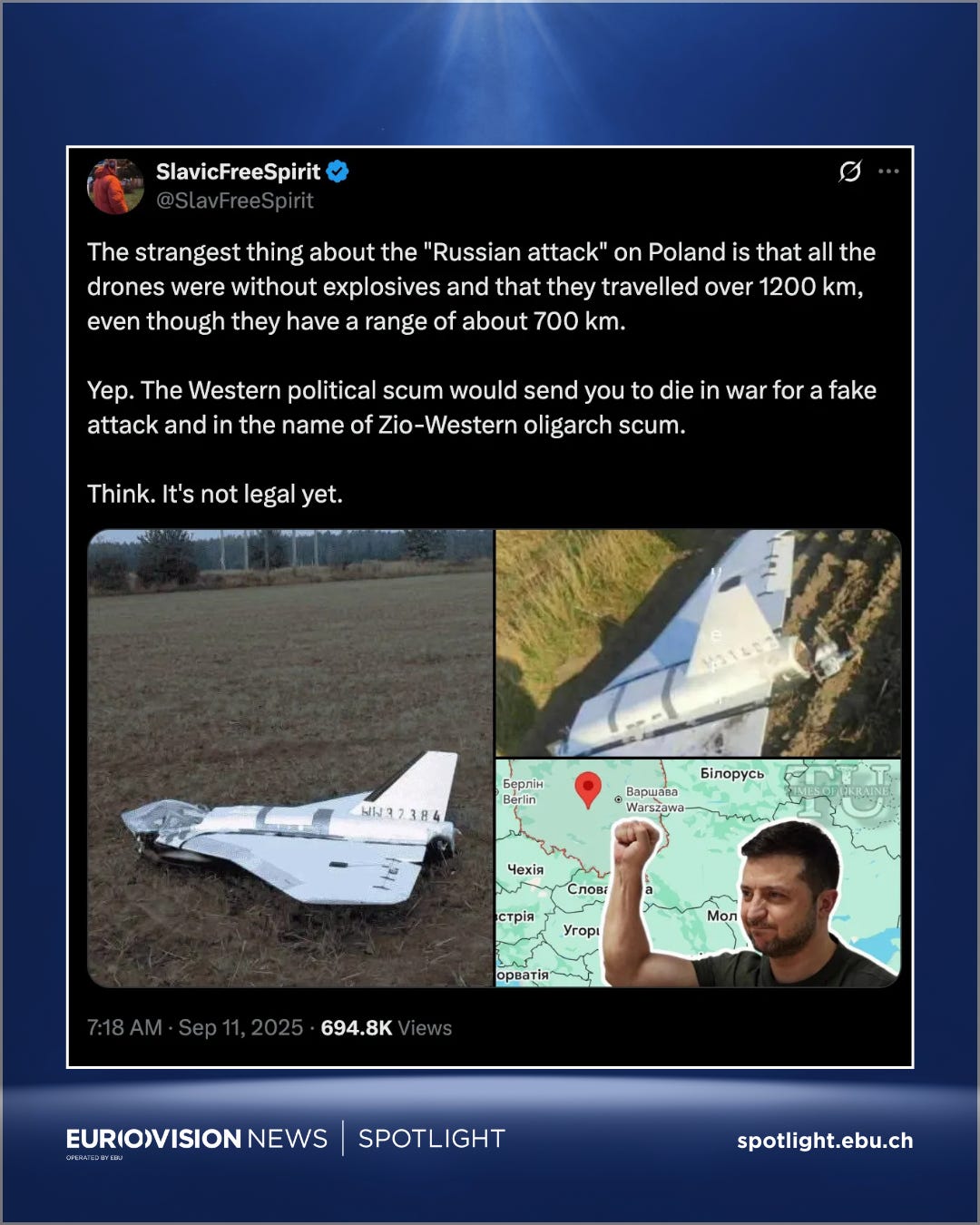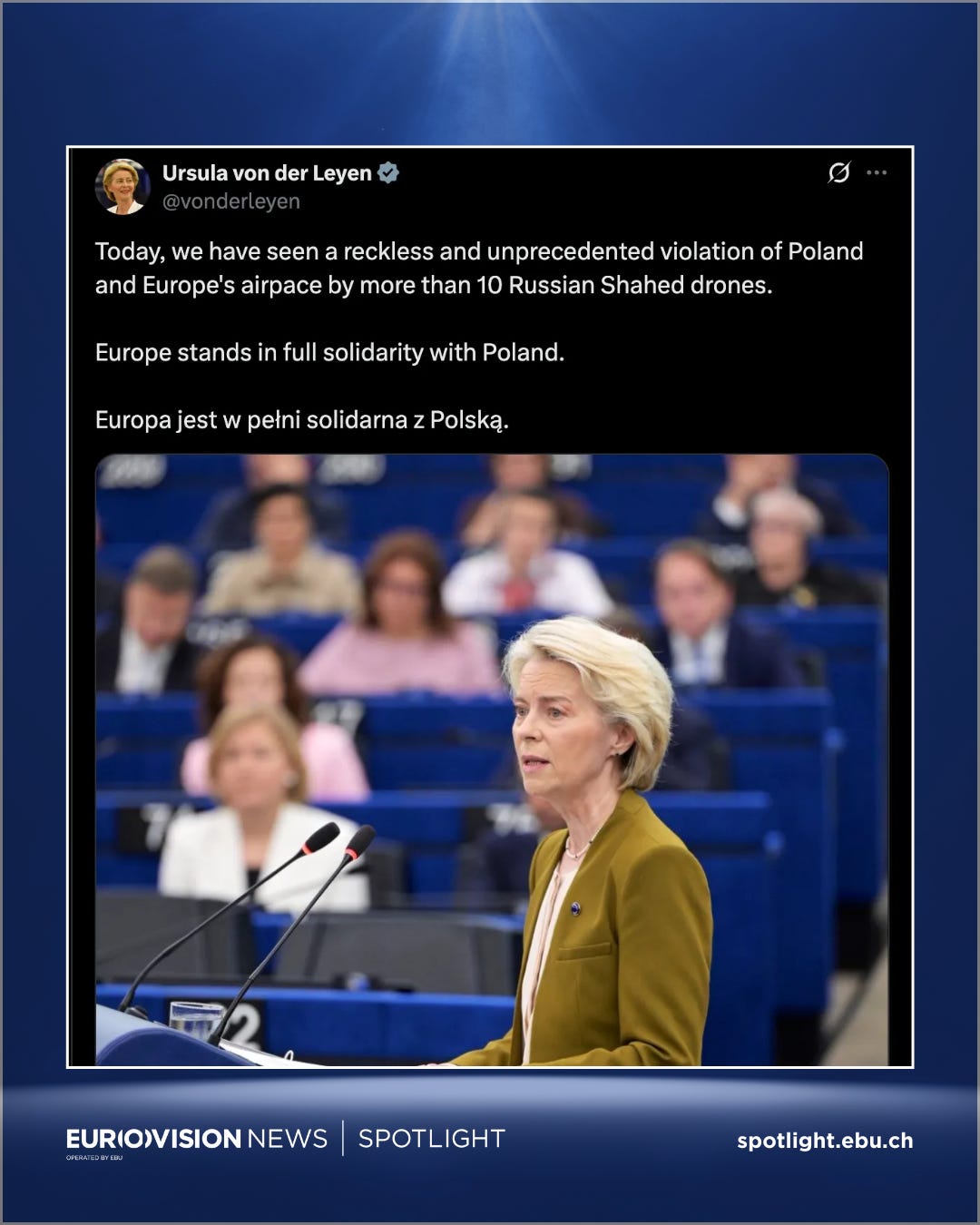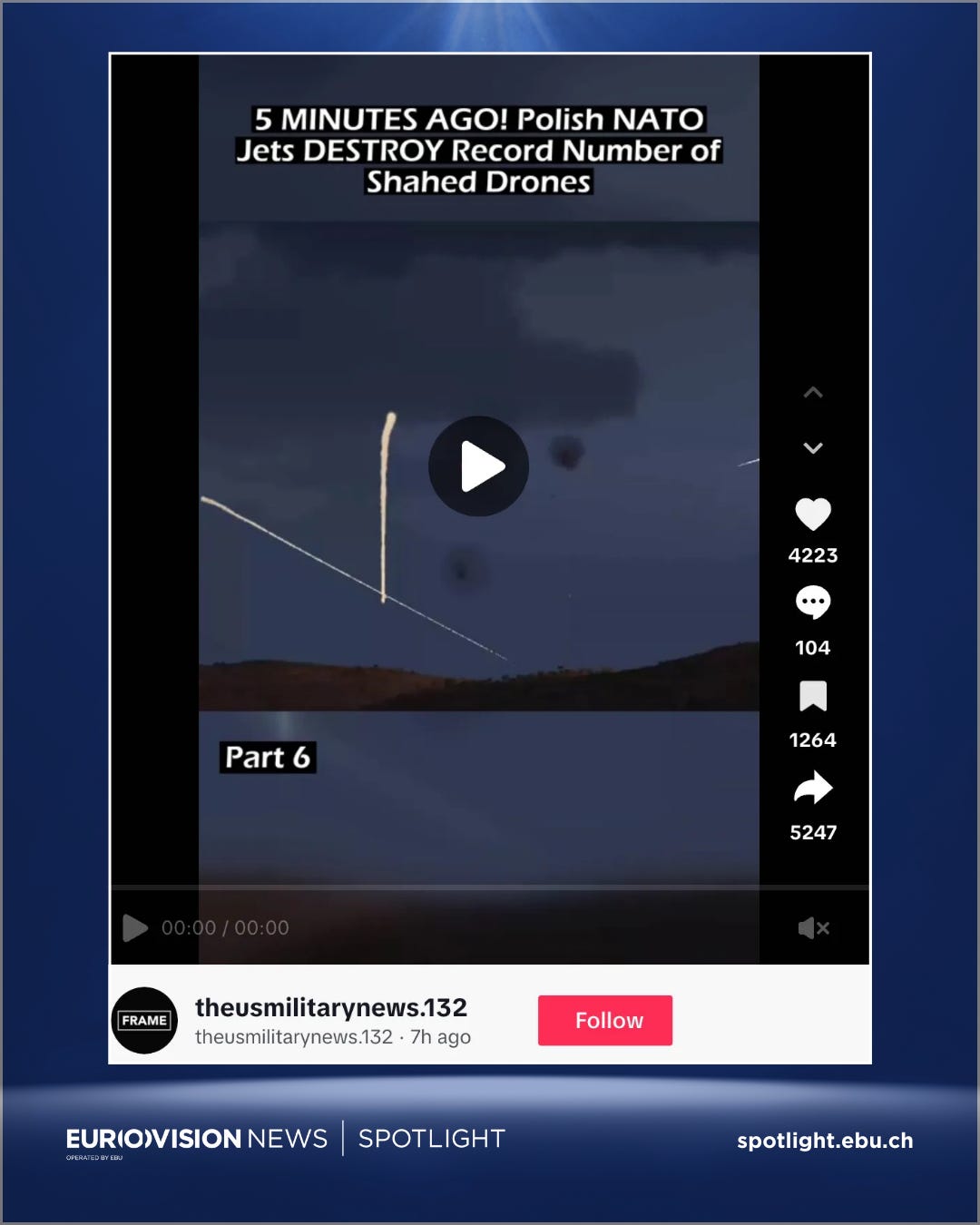Disinformation floods social media as Russian drones invade Polish airspace
Pro-Kremlin accounts called the incident a Ukrainian false flag amid other disinformation claims
At least three Russian drones were shot down by Poland and NATO during the night between September 9 and 10, 2025, Polish Prime Minister Donald Tusk said.
Poland detected 19 drone incursions in its airspace, coming amid an attack on Ukraine. Some fragments of the drones fell on Polish territory, causing damage to residential buildings, including a house in the village of Wyryki-Wola, in the Lublin region.
But while global leaders reacted to the airspace invasion with support for Poland and condemnation for Russia's actions, false narratives about the incursion proliferated on social media.
‘Ukrainian copies’ of Russian drones theory
The day after Poland shot down the drones, social media users immediately began claiming that the airspace invasion was not carried out by Russia.
Because the invasion of Polish airspace occurred while Russia was simultaneously targeting the city of Lviv, in Ukraine, social media users have been claiming that Ukraine took advantage of Russia's attack to launch false drones on Poland, attempting to drag NATO into a direct conflict against Russia.
For example, TikTok profile @briefinggoon on September 14 posted a video (archived here) with an AI voiceover and with the caption “Zelensky staged a false flag operation, trying to drag NATO into direct war with Russia,” garnering over 308,000 views in two days.
The false claim was also shared on X (archived here), Facebook (archived here) and Telegram (archived here), by pro-Russia social media users, garnering thousands of views. It quickly became one of the prevailing false narratives surrounding the airspace invasion.
Similar claims also circulated on September 14, after Romania's defence ministry stated it detected a Russian drone on the evening of September 13, when two F-16 jets were monitoring a location at the border with Ukraine.
According to the Ukrainian Center for Countering Disinformation, this narrative is part of a Russian propaganda strategy, which, in an attempt to absolve itself of the responsibility of the incursion, launched a disinformation campaign claiming that Ukraine launched the drones as a provocation with the goal of involving NATO in a direct confrontation against Russia.
"Such statements are untrue and represent a typical tactic of Russian propaganda, through which it attempts to justify all its crimes against the civilian population of Ukraine," the CCD stated in a September 10 Telegram post.
Polish Foreign Minister Radosław Sikorski said in his September 10 statement that the drones were Russian: “The assessment of Polish and NATO air forces is that they did not veer off course, but were deliberately targeted.”
His words were echoed by Krzysztof Gawkowski, Poland’s Deputy PM and Minister of Digital Affairs, who said: “Every word questioning the fact that we were dealing with a deliberate action supports Russian disinformation. Disinformation is also an element of war.”
Polish defense analyst and OSINT expert Jarosław Wolski stated that this type of disinformation campaign following the incursion was to be expected.
“We can expect an intensification of Russian information operations that will fuel a psychosis of fear around this incident and attempt to build a narrative about NATO's ineffectiveness, the low quality of the Polish Armed Forces, and Poland's inability to defend itself,” Wolski wrote.
Russia’s Defence Ministry immediately denied responsibility for the invasion of the airspace and stated that “the strike did not include any targets in the territory of the Republic of Poland, and that the range of the drones that delivered a strike at the Ukrainian defence industry facilities, which, according to Warsaw, entered Poland’s airspace, is below 700 kilometres. These facts overturn the myths which Poland is spreading again to aggravate the Ukrainian crisis.”
Social media users spreading this narrative claimed the false drones used by Ukraine were "visually identical" to the Geran-2 employed by Russia.
The Iranian drones Shahed-136 were licensed for domestic production in Russia under the name Geran-2, also known as Gerbera, and they have been regularly used by Russia since its invasion of Ukraine in February 2022, according to multiple reports.
Their peculiarity is to be able to fly behind their nominal range when stripped of warheads and when provided with extra fuel.
Ukrainian intelligence says that Gerbera are made of materials like plywood and foam and they are used as a cheap way to saturate Ukraine's air defences, Reuters reported.
The drones shot down in Poland were examined by experts contacted by the BBC, who compared their engines, guidance systems, fuselages, and production codes, with databases of already known Gerbera models. All the components appeared to match with typical Russian Geran-2 drones.
Social media users commented on the pictures of the drones that landed in Poland, pointing out that the materials, the components, and the duct tape used on the drones looked cheap, and claimed that Ukraine managed to create false Geran-2 by recovering fragments and assembling them together.
However, as a BBC analysis pointed out, Geran-2 drones are usually made with inexpensive materials, such as plywood, and can have an overall flimsy look. Their main purpose is to be decoys to saturate the airspace, triggering a defence response. Occasionally they can also be filled with explosive materials.
European Commission President Ursula von der Leyen also stated that the drones that invaded Polish airspace were Shahed drones, an Iranian design that Russia commonly uses for attacking Ukraine.
Moreover, the images of the drones that were shot down in September appear to be identical to the ones seen in Ukraine over the years and in Lithuania, where a drone from Belarus was found in July 2025.
It is also not the first time that a Russian drone was found in Poland. In August 2025, Polish authorities found debris of a Russian drone crashed into a field.
AI and video game clips support disinformation efforts
The violation of Polish airspace also led to the circulation of videos and images that purported to depict the drones, mostly on TikTok, DW reported.
TikTok profile @theusmilitarynews.123, which as of September 15 was no longer active, posted several videos in the aftermath of the incident, purportedly showing the Russian drones and the Polish response. One of the videos (archived here) stated: "5 Minutes ago! Polish NATO Jets destroy record number of Shahed drones." The videos all have the same look and some had garnered hundreds of thousands of views.
However, the videos did not show the recent drone attack, DW reported, but it featured scenes from the video game "Arma 3," as confirmed through a reverse image search that led to a YouTube account sharing images of the game. In the past the TikTok account regularly shared video game scenes presenting them as footage from the war in Ukraine.
Several other videos circulated on TikTok (archived here and here) purported to show appear to Russia’s incursion in Poland. They also appeared to have been AI-generated or taken from video games.
SOURCES
@wolski_jaros (2025) Available at: Russian drone attack through Polish territory. X [online] [Accessed 15 Sep. 2025].
X (formerly Twitter). (2025). Available at: Ukrainians has been highjacking Russian drone [Accessed 15 Sep. 2025].
X (formerly Twitter). (2025). Available at: Scott Ritter ON Russian Drones in Poland This is a false flag operation by the designed [Accessed 15 Sep. 2025].
X (formerly Twitter). (2025). Available at: Russia blames Ukraine for drone intrusion in Romania… [Accessed 16 Sep. 2025].
ЦЕНТР ПРОТИДІЇ ДЕЗІНФОРМАЦІЇ. Telegram. (2025). [online] Available at: https://t.me/CenterCounteringDisinformation/15563 [Accessed 15 Sep. 2025].
archive.is. (2025). Available at: Part 6 - 5 MINUTES AGO! Polish NATO Jets DESTROY Record Number of Sha…. [online] [Accessed 15 Sep. 2025].
Reuters (2025). Available at: What are the Gerbera drones used in Poland incursion? [online] Reuters. [Accessed 15 Sep. 2025].
News, BBC. (2022). Available at: How are ‘kamikaze’ drones being used by Russia and Ukraine? [online] Bbc.com. [Accessed 16 Sep. 2025].
Bbc.com. (2025). Available at: ‘Looks like a toy, but it’s real’: BBC examines a downed Russian drone. [online] [Accessed 16 Sep. 2025].
Defence-ua.com. (2020). Available at: They Can’t Even Make a Foam Drone Without China: Skywalker Technology Developed Gerbera Killer Drones For russia | Defense Express. [online] [Accessed 15 Sep. 2025].
Romanian Ministry of National Defence. (2025). Available at: Assessment of the incident produced by the penetration of a Russian drone into the national airspace. [online] [Accessed 16 Sep. 2025].
Saulius Jakučionis, BNS (2025). Available at: Explosive device found in drone from Belarus that crashed in Lithuania. [online] lrt.lt. [Accessed 15 Sep. 2025].
Crellin, Z. (2025). Available at: Polish officials say crashed drone is Russian ‘provocation’. [online] dw.com. [Accessed 15 Sep. 2025].
Thoms, S. (2025). Available at: Fact check: Russian drone downings in Poland spark disinfo. [online] dw.com. [Accessed 15 Sep. 2025].
PolskieRadio.pl. (2025). Available at: Experts debunk false claims about drones over Poland as government counters Russian disinformation. [online] [Accessed 15 Sep. 2025].
Verrecchia, F. (2025). Available at: La teoria infondata della ‘false flag’ ucraina e i falsi droni russi in Polonia. [online] Open. [Accessed 16 Sep. 2025].
StopFake.org (2025). Available at: Fake: Kyiv’s Electronic Warfare Knocked Russian Drones Off Course Into Poland. [online] StopFake. [Accessed 15 Sep. 2025].
Altman, H. (2025). Available at: Poland Says Russia’s Mass Drone Incursion Was ‘A Test’. [online] The War Zone. [Accessed 15 Sep. 2025].



